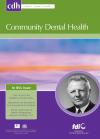Community Dental Health

- Cover Date:
- June 2006
- Print ISSN:
- 0265 539X
- Vol:
- 23
- Issue:
- 2
Prevalence of hypodontia and hyperdontia in paedodontic and orthodontic patients in Budapest
Various publications have reported the prevalence of accessory teeth to be between 1 and 3%. In contrast, hypodontia has a much higher prevalence. In the current work, the authors studied OP radiographs on 2,219 patients aged 6 to 18 years who presented at the Department of Paedodontics and Orthodontics at Semmelweis University in Budapest (patients with systemic disease were excluded). The examined radiographs revealed a prevalence of accessory teeth of 1.53%. The sequence of prevalence was as follows: mesiodens > second incisor > ï¬rst incisor. 77.5% of the accessory teeth were located in the upper jaw, with 97.5% of those being present in the incisor region. Hypodontia was detected in 326 patients (14.69%); missing wisdom germs were not considered. The sequence of prevalence of missing germ was as follows: upper second incisor > lower second premolar > upper second premolar > lower ï¬rst incisor. Hypodontia in the molar region was observed in 15 cases (0.68%). The prevalence of oligodontia was 1.04%.
Key words: Accessory tooth, hyperdontia, hypodontia, oligodontia, paedodontic and orthodontic patients, partial anodontia, supernumerary tooth, supplementary tooth, total anodontia
- Article Price
- £15.00
- Institution Article Price
- £
- Page Start
- 80
- Page End
- 82
- Authors
- Katalin Gábris, Gábor Fábián, Miklós Kaán, Noémi Rózsa, Ildikó Tarján
Articles from this issue
- Title
- Pg. Start
- Pg. End
- Service quality implications of dental undergraduate outreach teaching for Primary Care Trusts in England, UK.
- 75
- 79
- Improving access to dental care in East London’s ethnic minority groups: community based, qualitative study
- 95
- 100
- The unequal burden related to the risk of oral cancer in the different regions of the Kingdom of Saudi Arabia
- 101
- 106
